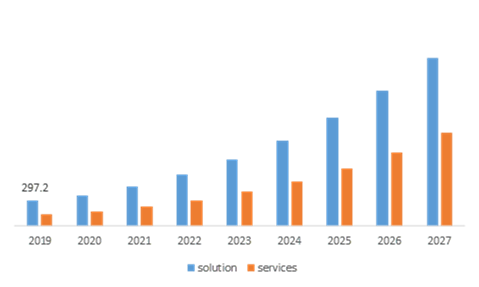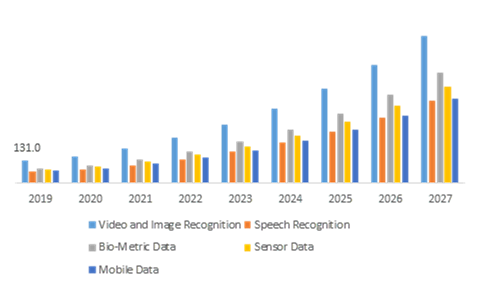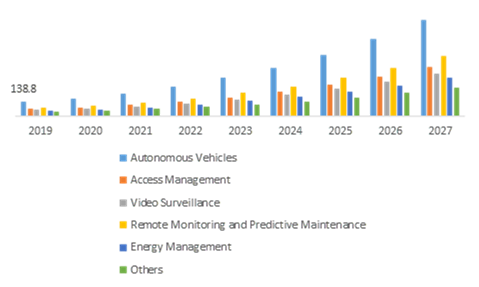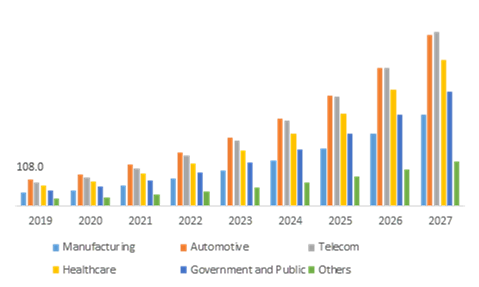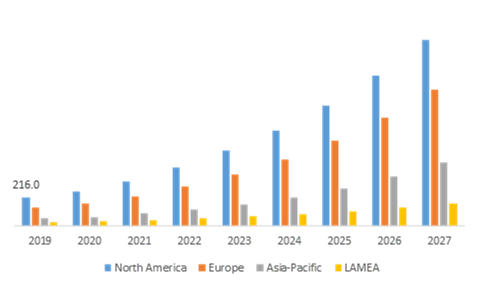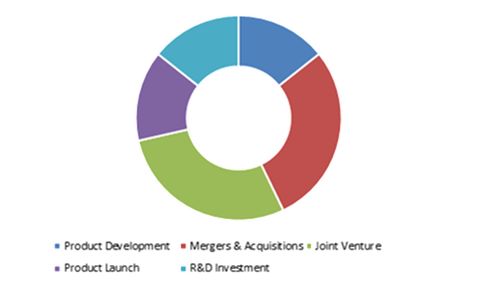Edge AI Software Market Report
RA00399
Edge AI Software Market, by Component (Solution and Service), By data source (Video and Image Recognition, Speech Recognition, Bio-Metric Data, Sensor Data and Mobile Data), by application (Autonomous Vehicles, Access Management, Video Surveillance, Remote Monitoring & Predictive Maintenance, Energy Management and Others), by End-use (Manufacturing, Automotive, Telecom, Healthcare, Government and Public and Others) and Regional Analysis (North America, Europe, Asia Pacific, and LAMEA): Global Opportunity Analysis and Industry Forecast, 2019–2027
The global edge AI software market accounted for $435.9 million in 2019 and is predicted to generate a revenue of $3,093.2 million by 2027 with a CAGR of 28.8% in the estimated period. North America accounted for $216.0 million in 2019 and is predicted to grow with a CAGR of 27.5% in the estimated period. Rise in the utilisation of edge AI software is predicted to be the major driving factor for the global market in the estimated period.
Market Analysis
Edge AI is defined as a process in which AI algorithms such as data from sensors or signals are processed on hardware and the software used for this purpose is known as edge AI software. Edge AI software allows real time operation such as data creation and decision actions. Edge AI software are utilized in production of wearables that enhance battery life of wearable devices. In addition, edge AI software avoids complications of streaming and can store large amount of data to the cloud that in turn enhances the privacy of the stored data. Besides, this software is utilized in telecom and enterprise segment that supports multi-cloud and enables to run edge AI analytical software that helps to gain complete action in less time.
COVID 19 Impact on the Edge AI Software Market
The pandemic has created a positive impact on the global edge AI software market. It has been noticed that due to pandemic most of the organisations are shut down. The manufacturing units have been impacted negatively due to the pandemic. Most companies are preferring to adopt edge AI software for complete automation in work processes to run the operational flow smoothly, which is predicted to boost the global market in the estimated period.
Increasing utilization of edge AI software in telecom end-user is anticipated to drive the global edge AI software market
Edge AI software are utilized in telecom sector owing to the advantages such as 360 insight capability across the connected systems, contextual push intelligence, availability of productivity tools in one place, and others. Growing number of internet users around the globe has led to the modernization of connected networks so that edge AI software can deliver enhanced working capacity. Telecom companies used to operate network on hardware systems earlier, but with the edge AI software, telecom industry can handle growing number of connected devices with ease. Edge AI software is utilized in connected vehicles as it helps to process data immediately with safe hardware that is utilized to run the connected cars or autonomous vehicles. For instance, Pony.AI and Bosch have collaborated on fleet management of automobile vehicles with the help of AI software. Edge AI software is utilized in management of various data which in turn enables business to improve speed, bandwidth, enhanced data analysis, improved individual experience, and decrease latency, which is predicted to boost the global market in the estimated period.
Ethical issue, privacy concern and lack of skilled employees is predicted to hamper the market growth in the forecast period
Edge AI software are helpful in business enhancement but ethical issues are restricting the use of edge AI software. Moreover, the edge AI software is a new technology for most organisations. The lack of skilled labour in this field is predicted to hinder the market growth in the estimated period.
Edge AI Software Market, by Component:
Solution sub- segment is predicted to be the most lucrative segment
Source: Research Dive Analysis
Solution sub-segment is predicted to have the highest market share. Solution segment accounted for $297.2 million in 2019 and is predicted to grow with a CAGR of 27.9% in the estimated period. Solution component helps to captured data and it can be utilized for designing models, application scenarios as well as the application software that enables to run edge AI on different IoT devices, which is predicted to drive the sub-segment market in the estimated period.
Edge AI Software Market, by Data Source:
Video and image recognition sub-segment is predicted to have highest market share
Source: Research Dive Analysis
Video and image recognition sub-segment are predicted to grow enormously. Video and image recognition sub-segment accounted for $131.0 million in 2019 and is predicted to grow with a CAGR of 27.9% in the estimated period. Wide utilization of video and image data source for identification of suspects in AI accelerated systems efficiently for analysing and processing of videos and images in various places is predicted to drive the sub-segment market in the forecast period.
Edge AI Software Market, by Application:
Autonomous vehicles sub-segment is predicted dominate the market till 2027
Source: Research Dive Analysis
Autonomous vehicles sub-segment is predicted to have maximum market share in the estimated period. Autonomous vehicles sub-segment accounted for $138.8 million in 2019 and is predicted to grow with a CAGR of 28.2% in the estimated period. Increase in the production of autonomous vehicle to minimize road accidents and improved transportation systems are significantly driving the adoption of edge AI software for autonomous vehicles application in the estimated period.
Edge AI Software Market, by End-Use:
Automotive segment is predicted to be the most profitable segment
Source: Research Dive Analysis
Automotive sub-segment is predicted to have highest market share in the estimated period. Automotive segment accounted for $108.0 million in 2019 and is predicted to grow with a CAGR of 27.7% in the estimated period. Wide utilization of edge AI software in automotive sectors for various purposes such as manufacturing of autonomous vehicles, develop sustainable transportation and production automotive parts is predicted to boost the sub-segment market in the estimated period.
Edge AI Software Market, by Region:
North America region market is predicted to create more investments opportunities for investors in the estimated timeframe
Source: Research Dive Analysis
North America region market is predicted to have the maximum market share in the estimated period. North America accounted for $216.0 million in 2019 and is predicted to grow with a CAGR of 27.5% in the estimated period. Presence of large number of companies and adoption of various advanced technology is predicted to boost the region market in the estimated period. Favourable government initiatives to support the development of edge AI software in North America region is expected to create huge growth opportunities in the coming years.
Key Participants in the Edge AI Software Market:
Source: Research Dive Analysis
The major key player in the global edge AI software market are International Business Machine (IBM), Microsoft,, Foghorn Systems In Vision AI, Anagog,, Amazon Web Services, TIBCO, Imagimob AB., Veea Inc., Tact.ai Technologies Inc. among other. For instance, NuTonomy is a MIT spin-off technology startup company and engaged in the development of driverless cars by utilizing nuTonomy’s technology. This technology provides flexible and human-like handling of automobiles without errors.
Porter’s Five Forces Analysis for Edge AI Software Market:
-
Bargaining Power of Suppliers: The switching cost from one supplier to another is projected to be low. The bargaining power of suppliers is very moderate.
-
Bargaining Power of Consumers: In this market, the concentration of buyers is high. The bargaining power of consumers is moderate.
-
Threat of New Entrants: Huge initial investments are essential to start a new edge AI software organization. The threat of new entrants is Low.
-
Threat of Substitutes: This market has numerous alternatives of products; moreover, technology also offers high switching costs for clients. The threat of substitutes is high.
-
Competitive Rivalry in the Market: The edge AI software market has only major players to sell their products and it becomes difficult for small and medium enterprises and local manufacturer to get into the market. The competitive rivalry in the industry is Moderate.
| Aspect | Particulars |
| Historical Market Estimations | 2019-2020 |
| Base Year for Market Estimation | 2019 |
| Forecast timeline for Market Projection | 2019-2027 |
| Geographical Scope | North America, Europe, Asia-Pacific, LAMEA |
| Segmentation by Component |
|
| Segmentation by Data Source |
|
| Segmentation by Application |
|
| Segmentation by End-User |
|
| Key Countries Covered | U.S., Canada, Mexico, Germany, France, UK, Italy, Spain, Russia, Rest of Europe, China, Japan, India, Australia, South Korea, Latin America, Middle East, Africa |
| Key Companies Profiled |
|
Q1. What is the size of edge AI software market?
A. The global edge AI software market size was over $435.9 million in 2019 and is predicted to grow with a CAGR of 28.8% over the forecast period.
Q2. Which are the leading companies in the edge AI software market?
A. IBM and Microsoft Corporation are the key players in the global edge AI software market.
Q3. Which region possesses greater investment opportunities in the coming future?
A. North America possesses great investment opportunities for the investors to witness the most promising growth in the coming years.
Q4. What is the growth rate of North America?
A. North America edge AI software market is projected to grow at 27.5% CAGR during the forecast period.
Q5. What are the strategies opted by the leading players in this market?
A. Product development is the key strategies opted by the operating companies in this edge AI software market.
Q6. Which companies are investing more on R&D practices?
A. IBM is the company investing more on R&D activities for developing new products and technologies.
1. Research Methodology
1.1. Desk Research
1.2. Real time insights and validation
1.3. Forecast model
1.4. Assumptions and forecast parameters
1.4.1. Assumptions
1.4.2. Forecast parameters
1.5. Data sources
1.5.1. Primary
1.5.2. Secondary
2. Executive Summary
2.1. 360° summary
2.2. Component trends
2.3. Data source trends
2.4. Data Source trends
2.5. End-Use trends
3. Market overview
3.1. Market segmentation & definitions
3.2. Key takeaways
3.2.1. Top investment pockets
3.2.2. Top winning strategies
3.3. Porter’s five forces analysis
3.3.1. Bargaining power of consumers
3.3.2. Bargaining power of suppliers
3.3.3. Threat of new entrants
3.3.4. Threat of substitutes
3.3.5. Competitive rivalry in the market
3.4. Market dynamics
3.4.1. Drivers
3.4.2. Restraints
3.4.3. Opportunities
3.5. Technology landscape
3.6. Regulatory landscape
3.7. Patent landscape
3.8. Pricing overview
3.8.1. By component
3.8.2. By data Source
3.8.3. By application
3.8.4. By end user
3.8.5. By region
3.9. Market value chain analysis
3.9.1. Stress point analysis
3.9.2. Raw material analysis
3.9.3. Manufacturing process
3.9.4. Distribution channel analysis
3.9.5. Operating vendors
3.9.5.1. Raw material suppliers
3.9.5.2. Product manufacturers
3.9.5.3. Product distributors
3.10. Strategic overview
4. Edge AI Software Market, by Component
4.1. Solution
4.1.1. Market size and forecast, by region, 2019-2026
4.1.2. Comparative market share analysis, 2019-2026
4.2. Services
4.2.1. Market size and forecast, by region, 2019-2026
4.2.2. Comparative market share analysis, 2019-2026
5. Edge AI Software Market, by Data Source
5.1. Video and Image Recognition
5.1.1. Market size and forecast, by region, 2019-2026
5.1.2. Comparative market share analysis, 2019-2026
5.2. Speech Recognition
5.2.1. Market size and forecast, by region, 2019-2026
5.2.2. Comparative market share analysis, 2019-2026
5.3. Bio-Metric Data
5.3.1. Market size and forecast, by region, 2019-2026
5.3.2. Comparative market share analysis, 2019-2026
5.4. Sensor Data
5.4.1. Market size and forecast, by region, 2019-2026
5.4.2. Comparative market share analysis, 2019-2026
5.5. Mobile Data
5.5.1. Market size and forecast, by region, 2019-2026
5.5.2. Comparative market share analysis, 2019-2026
6. Edge AI Software Market, by Application
6.1. Autonomous Vehicles
6.1.1. Market size and forecast, by region, 2019-2026
6.1.2. Comparative market share analysis, 2019-2026
6.2. Access Management
6.2.1. Market size and forecast, by region, 2019-2026
6.2.2. Comparative market share analysis, 2019-2026
6.3. Video Surveillance
6.3.1. Market size and forecast, by region, 2019-2026
6.3.2. Comparative market share analysis, 2019-2026
6.4. Remote Monitoring and Predictive Maintenance
6.4.1. Market size and forecast, by region, 2019-2026
6.4.2. Comparative market share analysis, 2019-2026
6.5. Energy Management
6.5.1. Market size and forecast, by region, 2019-2026
6.5.2. Comparative market share analysis, 2019-2026
6.6. Others
6.6.1. Market size and forecast, by region, 2019-2026
6.6.2. Comparative market share analysis, 2019-2026
7. Edge AI Software Market, by End User
7.1. Manufacturing
7.1.1. Market size and forecast, by region, 2019-2026
7.1.2. Comparative market share analysis, 2019-2026
7.2. Automotive
7.2.1. Market size and forecast, by region, 2019-2026
7.2.2. Comparative market share analysis, 2019-2026
7.3. Telecom
7.3.1. Market size and forecast, by region, 2019-2026
7.3.2. Comparative market share analysis, 2019-2026
7.4. Healthcare
7.4.1. Market size and forecast, by region, 2019-2026
7.4.2. Comparative market share analysis, 2019-2026
7.5. Government and Public
7.5.1. Market size and forecast, by region, 2019-2026
7.5.2. Comparative market share analysis, 2019-2026
7.6. Others
7.6.1. Market size and forecast, by region, 2019-2026
7.6.2. Comparative market share analysis, 2019-2026
8. Edge AI Software Market, by Region
8.1. North Region
8.1.1. Market size and forecast, by Component, 2019-2026
8.1.2. Market size and forecast, by Data Source, 2019-2026
8.1.3. Market size and forecast, by Application, 2019-2026
8.1.4. Market size and forecast, by End User, 2019-2026
8.1.5. Market size and forecast, by country, 2019-2026
8.1.6. Comparative market share analysis, 2019-2026
8.1.7. U.S
8.1.8. Market size and forecast, by Component, 2019-2026
8.1.9. Market size and forecast, by Data Source, 2019-2026
8.1.10. Market size and forecast, by Application, 2019-2026
8.1.11. Market size and forecast, by End User, 2019-2026
8.1.12. Comparative market share analysis, 2019-2026
8.1.13. Canada
8.1.14. Market size and forecast, by Component, 2019-2026
8.1.15. Market size and forecast, by Data Source, 2019-2026
8.1.16. Market size and forecast, by Application, 2019-2026
8.1.17. Market size and forecast, by End User, 2019-2026
8.1.18. Comparative market share analysis, 2019-2026
8.1.19. Mexico
8.1.20. Market size and forecast, by Component, 2019-2026
8.1.21. Market size and forecast, by Data Source, 2019-2026
8.1.22. Market size and forecast, by Application, 2019-2026
8.1.23. Market size and forecast, by End User, 2019-2026
8.1.24. Comparative market share analysis, 2019-2026
8.2. Europe
8.2.1. Market size and forecast, by Component, 2019-2026
8.2.2. Market size and forecast, by Data Source, 2019-2026
8.2.3. Market size and forecast, by Application, 2019-2026
8.2.4. Market size and forecast, by End User, 2019-2026
8.2.5. Comparative market share analysis, 2019-2026
8.2.6. Germany
8.2.7. Market size and forecast, by Component, 2019-2026
8.2.8. Market size and forecast, by Data Source, 2019-2026
8.2.9. Market size and forecast, by Application, 2019-2026
8.2.10. Market size and forecast, by End User, 2019-2026
8.2.10.1. Comparative market share analysis, 2019-2026
8.2.11. France
8.2.11.1. Market size and forecast, by Component, 2019-2026
8.2.11.2. Market size and forecast, by Data Source, 2019-2026
8.2.11.3. Market size and forecast, by Application, 2019-2026
8.2.11.4. Market size and forecast, by End User, 2019-2026
8.2.11.5. Comparative market share analysis, 2019-2026
8.2.12. Italy
8.2.12.1. Market size and forecast, by Component, 2019-2026
8.2.12.2. Market size and forecast, by Data Source, 2019-2026
8.2.12.3. Market size and forecast, by Application, 2019-2026
8.2.12.4. Market size and forecast, by End User, 2019-2026
8.2.12.5. Comparative market share analysis, 2019-2026
8.2.13. Rest of Europe
8.2.13.1. Market size and forecast, by Component, 2019-2026
8.2.13.2. Market size and forecast, by Data Source, 2019-2026
8.2.13.3. Market size and forecast, by Application, 2019-2026
8.2.13.4. Market size and forecast, by End User, 2019-2026
8.2.13.5. Comparative market share analysis, 2019-2026
8.3. Asia-Pacific
8.3.1. Market size and forecast, by Component, 2019-2026
8.3.2. Market size and forecast, by Data Source, 2019-2026
8.3.3. Market size and forecast, by Application, 2019-2026
8.3.4. Market size and forecast, by End User, 2019-2026
8.3.5. Market size and forecast, by country, 2019-2026
8.3.6. Comparative market share analysis, 2019-2026
8.3.7. China
8.3.7.1. Market size and forecast, by Component, 2019-2026
8.3.7.2. Market size and forecast, by Data Source, 2019-2026
8.3.7.3. Market size and forecast, by Application, 2019-2026
8.3.7.4. Market size and forecast, by End User, 2019-2026
8.3.7.5. Comparative market share analysis, 2019-2026
8.3.8. India
8.3.8.1. Market size and forecast, by Component, 2019-2026
8.3.8.2. Market size and forecast, by Data Source, 2019-2026
8.3.8.3. Market size and forecast, by Application, 2019-2026
8.3.8.4. Market size and forecast, by End User, 2019-2026
8.3.8.5. Comparative market share analysis, 2019-2026
8.3.9. Japan
8.3.9.1. Market size and forecast, by Component, 2019-2026
8.3.9.2. Market size and forecast, by Data Source, 2019-2026
8.3.9.3. Market size and forecast, by Application, 2019-2026
8.3.9.4. Market size and forecast, by End User, 2019-2026
8.3.9.5. Comparative market share analysis, 2019-2026
8.3.10. South Korea
8.3.10.1. Market size and forecast, by Component, 2019-2026
8.3.10.2. Market size and forecast, by Data Source, 2019-2026
8.3.10.3. Market size and forecast, by Application, 2019-2026
8.3.10.4. Market size and forecast, by End User, 2019-2026
8.3.10.5. Comparative market share analysis, 2019-2026
8.3.11. Australia
8.3.11.1. Market size and forecast, by Component, 2019-2026
8.3.11.2. Market size and forecast, by Data Source, 2019-2026
8.3.11.3. Market size and forecast, by Application, 2019-2026
8.3.11.4. Market size and forecast, by End User, 2019-2026
8.3.11.5. Comparative market share analysis, 2019-2026
8.3.12. Rest of Asia Pacific
8.3.12.1. Market size and forecast, by Component, 2019-2026
8.3.12.2. Market size and forecast, by Data Source, 2019-2026
8.3.12.3. Market size and forecast, by Application, 2019-2026
8.3.12.4. Market size and forecast, by End User, 2019-2026
8.3.12.5. Comparative market share analysis, 2019-2026
8.4. LAMEA
8.4.1. Market size and forecast, by Component, 2019-2026
8.4.2. Market size and forecast, by Data Source, 2019-2026
8.4.3. Market size and forecast, by Application, 2019-2026
8.4.4. Market size and forecast, by End User, 2019-2026
8.4.5. Market size and forecast, by country, 2019-2026
8.4.6. Comparative market share analysis, 2019-2026
8.4.7. Latin America
8.4.7.1. Market size and forecast, by Component, 2019-2026
8.4.7.2. Market size and forecast, by Data Source, 2019-2026
8.4.7.3. Market size and forecast, by Application, 2019-2026
8.4.7.4. Market size and forecast, by End User, 2019-2026
8.4.7.5. Comparative market share analysis, 2019-2026
8.4.8. Middle East
8.4.8.1. Market size and forecast, by Component, 2019-2026
8.4.8.2. Market size and forecast, by Data Source, 2019-2026
8.4.8.3. Market size and forecast, by Application, 2019-2026
8.4.8.4. Market size and forecast, by End User, 2019-2026
8.4.8.5. Comparative market share analysis, 2019-2026
8.4.9. Africa
8.4.9.1. Market size and forecast, by Component, 2019-2026
8.4.9.2. Market size and forecast, by Data Source, 2019-2026
8.4.9.3. Market size and forecast, by Application, 2019-2026
8.4.9.4. Market size and forecast, by End User, 2019-2026
8.4.9.5. Comparative market share analysis, 2019-2026
9. Company profiles
9.1. International Business Machine (IBM),
9.1.1. Business overview
9.1.2. Financial performance
9.1.3. Product portfolio
9.1.4. Recent strategic moves & developments
9.1.5. SWOT analysis
9.2. Microsoft.
9.2.1. Business overview
9.2.2. Financial performance
9.2.3. Product portfolio
9.2.4. Recent strategic moves & developments
9.2.5. SWOT analysis
9.3. Foghorn Systems
9.3.1. Business overview
9.3.2. Financial performance
9.3.3. Product portfolio
9.3.4. Recent strategic moves & developments
9.3.5. SWOT analysis
9.4. In Vision AI.
9.4.1. Business overview
9.4.2. Financial performance
9.4.3. Product portfolio
9.4.4. Recent strategic moves & developments
9.4.5. SWOT analysis
9.5. Anagog.
9.5.1. Business overview
9.5.2. Financial performance
9.5.3. Product portfolio
9.5.4. Recent strategic moves & developments
9.5.5. SWOT analysis
9.6. Amazon Web Services
9.6.1. Business overview
9.6.2. Financial performance
9.6.3. Product portfolio
9.6.4. Recent strategic moves & developments
9.6.5. SWOT analysis
9.7. TIBCO.
9.7.1. Business overview
9.7.2. Financial performance
9.7.3. Product portfolio
9.7.4. Recent strategic moves & developments
9.7.5. SWOT analysis
9.8. Imagimob AB
9.8.1. Business overview
9.8.2. Financial performance
9.8.3. Product portfolio
9.8.4. Recent strategic moves & developments
9.8.5. SWOT analysis
9.9. Veea Inc
9.9.1. Business overview
9.9.2. Financial performance
9.9.3. Product portfolio
9.9.4. Recent strategic moves & developments
9.9.5. SWOT analysis
9.10. Tact.ai Technologies Inc
9.10.1. Business overview
9.10.2. Financial performance
9.10.3. Product portfolio
9.10.4. Recent strategic moves & developments
9.10.5. SWOT analysis
Analyst Review:
Edge artificial intelligence (AI) is as a process in which AI algorithms such as data from signals or sensors are processed and analyzed on a hardware or at the edge, end devices. The software used for this purpose is called as edge AI software. This software allows real-time operation such as decision actions and data creation. Edge AI software is utilized in production of wearables that help in enhancing battery life of hardware devices. Besides, edge AI software evades complications of streaming and have the capability to store huge amount of data to the cloud, which in turn enhances the privacy of the stored data.
Edge AI software is extensively used where even milliseconds of delay in data transmission is unaffordable, low power consumption is a requirement, and sensitive data should not leave the hardware device. Edge AI software is utilized in enterprise and telecom segment that allows to run edge AI analytical software and supports multi-cloud to obtain complete action in less time.
Impact of COVID-19 on the Global Industry
The global edge AI software market is projected to witness a positive growth during the COVID-19 pandemic due to the increasing preference of companies to adopt edge AI software for smooth operational flow in business. Moreover, the key industry players of the market are adopting several strategies and launching novel technologies and products in the market, which is expected to boost the market growth in the pandemic crisis.
For instance, in May 2020, a global leader in edge AI technology, ONE Tech announced the launch of novel strategy to help organizations minimize operational inefficiencies, enhance privacy and security for IoT application through edge AI software solutions, and improve industrial production. ONE Tech’s award-winning MicroAI technology is utlilized by OEMs and enterprises across the globe as a tool to reach deeper insights into the behavior of machines, devices, and processes within their organizations.
In August 2020, California-based AI developer, Blaize launched its first products namely, Xplorer and Pathfinder. According to the company Blaize AI edge suite computing products overcome limitations of complexity, power, and cost to unleash the adoption of AI at the edge. The Blaize AI software suite has ease of accessibility and is built on open standards to liberate product developers.
Key Developments in the Global Market
The major industry players are implementing numerous growth strategies such as technological advancements, novel product launches, and mergers & acquisitions to gain a strong position in the overall market, which is consequently supporting the edge AI software market to grow at a significant pace.
For instance, in December 2019, ADLINK Technology partnered with Amazon Web Services (AWS) and Intel in order to offer AI at the edge for applications of machine vision. The ADLINK edge AI solution features Intel Distribution of OpenVINO toolkit, Amazon Sagemaker, AWS Greengrass, ADLINK Data River, and ADLINK Edge software suite.
Forecast Analysis of Edge AI Software Market
Global edge AI software market is anticipated to experience a notable growth over the period of forecast due to increasing utilization of edge AI software in connected vehicles as it assists to immediately process data used to run the autonomous vehicles or connected cars. The continuous technological advancements in the edge AI software is predicted to play a vital role in creating lucrative growth opportunities in the global market. However, lack of skilled labor, and ethical issues associated with edge AI software are major factors expected to impede the market growth in the near future.
A surge in the adoption & utilization of edge AI software in the telecom industry coupled with numerous advantages such as availability of productivity tools at one place and others is a major factor estimated to escalate the growth of the global edge AI software market by 2027. Research Dive in its latest published report anticipates that the edge AI software market will grow at a CAGR of 28.8% during the forecast period. The North America region is predicted to hold the maximum number of share in the global market throughout the forecast period owing to the presence of key industry players and favorable government initiatives for development of edge AI software in the region. The key players functioning in the global industry include Tact.ai Technologies Inc., International Business Machine (IBM), Veea Inc., Microsoft Corporation, Imagimob AB, Foghorn Systems, Inc., TIBCO Software Inc., In Vision AI, Amazon Web Services (AWS), and Anagog Ltd.
Personalize this research
- Triangulate with your own data
- Request your format and definition
- Get a deeper dive on a specific application, geography, customer or competitor
- + 1-888-961-4454 Toll - Free
- support@researchdive.com

